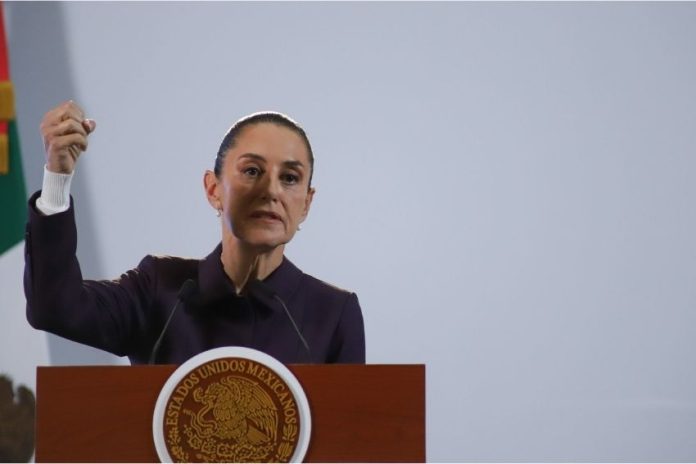Reviewing hundreds of thousands of water use permits is a key focus of the National Water Plan presented by the federal government on Thursday.
President Claudia Sheinbaum said that one of the “essences” of the plan is to recognize water as a human right rather than a “good” to be sold.

She noted that the plan aims to “sort out” the water concessions issued to private and public interests over the years and identify those not being used.
“There are people who have a water concession but don’t use it; they even sell it in some cases. … What we want is for water that isn’t being used to be returned to the nation, … even municipalities have water concessions,” Sheinbaum told her morning press conference.
“… Water belongs to the nation. … Fortunately we’ve had a lot of dialogue … with industry and with irrigation districts, and they’re willing … to return water concessions they are not using,” she said.
Sheinbaum said the plan will allow the government to “reduce overexploitation and make water available … for human consumption.”
Water shortages affect various parts of Mexico including Mexico City, where at least 60 companies reportedly have permits allowing them to extract more than 1 million liters of water per day from the Valley of Mexico’s water supply.

Mexico currently has low water reserves, even after a rainy summer, amplifying concerns about current and future water scarcity and making the implementation of a plan to remedy the situation essential.
Water usage in Mexico
Before examining the details of the National Water Plan, it is pertinent to look at how water is used in Mexico.
National Water Commission (Conagua) General Director Efraín Morales López told Sheinbaum’s Thursday morning press conference that 76% of water in Mexico goes to the agricultural sector and 9% is used by industry (including for electricity generation).
The remaining 15% of water is allocated to “public urban use,” Morales said.
The National Water Plan’s objectives and 4 central tenets
The Conagua chief said that the objectives of the water plan are to:
- Guarantee the human right to water in sufficient quantity and quality.
- Ensure the sustainability of Mexico’s water resources.
- Promote responsible water management.
Morales said that the plan is based on four central tenets:
- Water policy that supports national sovereignty.
- Universal access to water.
- Mitigation of climate change.
- Comprehensive and transparent management of water resources.

The specific ‘actions’ of the water plan
1. Revision of water concessions.
Morales said that Conagua is reviewing all water use permits and identifying “those that aren’t being used” with the aim of reincorporating the volumes of water allocated via concessions to “national availability.”
He said that around 2,600 concessions were issued between 1917 and 1992, but more than 360,000 were granted in the subsequent decade.
The issuance of so many permits led to overexploitation of water resources and other adverse impacts “that unfortunately we’re still experiencing,” Morales said.
2. A water ‘inspection program’

Morales said that Conagua, in conjunction with various federal departments and state and municipal authorities, would “implement an inspection program in the whole country to put order to the use of water.”
The aim is to detect illegal, improper and wasteful use of water.
“Our main collaborator will be the people of Mexico, so we make a call to report any irregularity with regard to the use of water,” Morales said.
3. Law changes
Morales said that the government will present reforms to the National Water Law to prevent “any kind of speculation” on water including via the sale of water use permits.
He said that the “neoliberal model” that was in place for more than three decades before former president Andrés Manuel López Obrador took office in 2018 created an “alternative market” for water and that people “took advantage” and turned water into a “business.”

Offering an example, Morales said that some water permits issued for use in the agricultural sector were sold to real estate developers and factories.
4. Irrigation technology
The Conagua chief also outlined a plan to use technology to ensure the “more efficient” use of water in irrigation.
In conjunction with the Agriculture Ministry, “we’re going to apply technology to more than 200,000 hectares” of agricultural land, Morales said.
“… This will benefit … more than 225,000 farming families and also all the people of Mexico because we’re going to produce more food with less water,” he said.
“… Part of the water we save will be allocated to human consumption and to replenish our aquifiers,” Morales said.

Agriculture Minister Julio Berdegué Sacristán told Sheinbaum’s press conference that through the use of technology in irrigation, farmers will be able to “control very precisely how much water reaches each of their plants.”
He said that the Agriculture Ministry estimates that production on land where irrigation technology is used will consequently increase by 51%.
“So this doesn’t just contribute to [guaranteeing] the human right to water but also makes a formidable contribution to the nation’s food sovereignty,” Berdegué said.
5. Infrastructure projects
As part of the National Water Plan, “we’re going to carry out infrastructure projects in the whole country,” Morales said.
The Conagua chief enumerated more than a dozen projects, including various dam and aqueduct initiatives. Morales also mentioned a planned desalination plant in Baja California, projects to mitigate the effects of flooding in Tabasco and initiatives for central Mexico that Sheinbaum outlined earlier this year.

6. Cleaning up rivers
Morales said that on the “instructions of the president,” cleaning up contaminated rivers is also part of the National Water Plan.
“We’re going to give priority to the three most contaminated rivers in the country,” he said, noting that they are the Lerma-Santiago River in Jalisco, the Atoyac River in Puebla and Tlaxcala and the Tula River in Hidalgo.
“For the planning and execution of this program we’re working very closely and in a very coordinated way with the Environment Ministry, with [Environment Minister] Alicia Bárcena and also with local governments,” Morales said.
7. The National Agreement for the Human Right to Water and Sustainability
The Conagua chief said that the National Agreement for the Human Right to Water and Sustainability is an initiative in which irrigators — “the main industrial consumers” of water – educational institutes, communities and all three levels of government will participate.

The ultimate aim of the agreement is for water to be used in the most efficient way possible to ensure adequate supply.
Companies that sign on to the agreement will invest in “making their production processes more efficient in order to save water,” Morales said.
Some companies will also invest in water projects that benefit the communities in which they are located, he said.
“We have commitments for private investment of more than 16.4 billion pesos,” Morales said.
“And as part of this agreement, there will be an awareness campaign about saving water, about the use and care of water,” he said. “This agreement will be signed on Nov. 25.”
How much will the federal government spend on water projects in 2025?
At the conclusion of his presentation on the National Water Plan, Morales said that the government will invest approximately 20 billion pesos (close to US $1 billion) on water projects next year.
He described the “outlook” on the water situation in Mexico and the world as “complex, noting the prevalence of water stress and “complications that climate change brings.”
However, via the “equitable distribution” of water and “adequate management of our resources,” it will be possible to have a future in which water is not a “matter for dispute,” Morales said.
“… Let’s all remember that water is wellbeing,” he added.
By Mexico News Daily chief staff writer Peter Davies (peter.davies@mexiconewsdaily.com)
